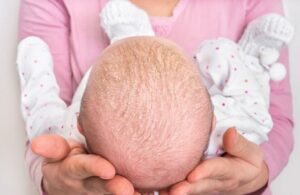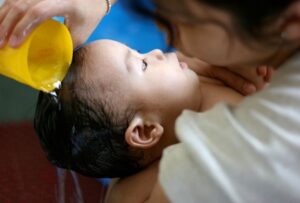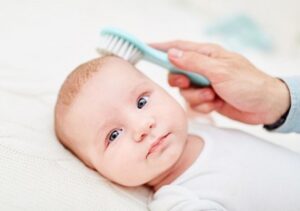 The baby’s skin is fragile and delicate, and the skin might quickly get dry and inflamed. Baby dandruff is the term used to describe the dry, flaky skin that appears on an infant’s scalp.
The baby’s skin is fragile and delicate, and the skin might quickly get dry and inflamed. Baby dandruff is the term used to describe the dry, flaky skin that appears on an infant’s scalp.
Baby dandruff may appear to be a medical disease, but there is no need for concern. Dandruff is a common condition that many infants experience at some point, and it’s not an indication of illness or bad hygiene; it typically disappears after a week.
Table of Contents
What is Baby Dandruff?
Baby dandruff, also known as seborrheic dermatitis, is like the dry, flaky skin that can appear on an adult’s scalp and affects your child’s scalp. Nevertheless, one significant distinction between newborn dandruff and the type occasionally affects grownups. Dandruff in infants can result in the disease cradle cap.
Severe infant dandruff called cradle cap causes crusty patches of the inflamed, yellow, or red epidermis. The cradle cap is natural, much like infant dandruff; most newborns get a cradle cap. In addition, according to one research, up to 70% of babies will experience cradle caps during the first three months of life.
Infant dandruff and cradle cap are not painful or uncomfortable for your baby, are not infectious, and usually go away in a week or two. It’s crucial to remember that infant dandruff doesn’t always turn into a cradle cap, and your child’s scalp can continue to be dry and flaky in its natural condition.
Symptoms of Baby Dandruff
Your child may show several various symptoms of dandruff. Among the most typical signs are listed below:
- Your baby’s head has flaky, dry skin.
- Your infant’s head and surrounding area are colored red, pink, or yellow.
- Oily, slimy, greasy, or rough to feel dry.
Even though infant dandruff is ugly, remember that it rarely causes significant pain. Baby dandruff is quite prevalent in infants younger than a year old and is not communicable or the result of bad hygiene practices.
How do You Distinguish Newborn Dandruff
 First, the baby’s head will not primarily develop any other skin disorders, and your child’s body is likely to be covered in them, such as the legs, arms, and torso. But on the other side, baby dandruff is limited to your child’s scalp.
First, the baby’s head will not primarily develop any other skin disorders, and your child’s body is likely to be covered in them, such as the legs, arms, and torso. But on the other side, baby dandruff is limited to your child’s scalp.
In addition, several other skin disorders, such as hives and heat rash, may manifest themselves rapidly. It will assist you in ruling out baby dandruff as the root issue. Finally, although most other skin problems will make your infant noticeably uncomfortable, baby dandruff won’t. It’s possible that dandruff is not the cause of your child’s dry, irritated skin or overly fussy behavior.
Causes of Baby Dandruff
The fundamental answer is that newborn dandruff is brought on by dry skin. However, it begs the question of what brings on the dry skin that results in newborn dandruff.
Many things can cause dry skin, which can cause newborn dandruff.
- Fungal Growth
- Too Much Shampoo
- Not Shampooing Enough
- Skin Conditions
- Heat
- Oily Scalp
- Sunburn on your baby’s scalp
- Using a harsh shampoo or too much shampoo
- Not rinsing your baby’s head well enough after shampooing
- Extreme weather
- Excess sebum on your baby’s scalp
Additionally, some medical professionals think that a yeast named Malassezia may cause infant dandruff and cradle cap, and studies have not yet backed this up. It’s also crucial to remember that other skin issues like eczema and psoriasis can occasionally make newborn dandruff worse.
Ways to Getting Rid of Baby Dandruff
After discussing the signs and causes of infant dandruff, let’s move on to eight simple ways to treat your child’s dry scalp.
Brush the Baby’s Dry Hair
To remove some flakes from your baby’s head, gently brush their scalp, but take better care not to scrape or scratch at the bits. You may purchase specific cradle cap brushes. Sometimes, doctors send new parents home with a brush after the baby is delivered. It also helps with a fresh toothbrush with soft bristles.
To apply this method:
- Brush the afflicted scalp patch gently on one side to remove flakes.
- To eliminate flakes from each hair strand, keep combing through the hair.
- You can do it on either dry or damp hair.
Brush only once a day. Comb less frequently if the scalp feels irritated or red.
A few flakes may get removed by brushing, which could improve the condition of the whole scalp.
Use of Mineral Oil
Mineral oil, also known as “baby oil,” is considered to help release stalled flakes left on the scalp and lessen cradle cap signs. Mineral oil has not yet been effective, despite being a widely used home treatment.
If you decide to use mineral oil on your newborn, rub it lightly into their scalp before shampooing. Use a brush to exfoliate the flakes on the scalp for added advantages. Before washing off, let the oil sit in place for a few moments.
Use Regular Baby Shampoo
Because it cleanses a few of the additional oils off, keeping your baby’s scalp fresh aids in the resolution of the problem. Massage the afflicted parts lightly with baby shampoo. Your doctor may advise you to clean your child’s hair more frequently than usual. Rather than washing it every few days, you may need to do so every day.
If gentle baby shampoo is ineffective, talk to your doctor about medications. Only use shampoo-containing components to treat dandruff if your physician advises you to. Not every product is suitable for babies.
Use Medical Dandruff Shampoo
Try an over-the-counter medicated shampoo if using ordinary baby shampoo fails to produce the desired results. Choose one that is specially designed for infants. Seek anti-dandruff shampoos that include pyrithione zinc or selenium sulfide for dandruff and eczema.
Stronger anti-dandruff shampoos, like those with tar or salicylic acid, may be necessary for more difficult cradle cap patches. You can get advice on the best shampoo from your baby’s doctor or a pharmacist.
The most important thing is to let the medicated shampoo sit on your baby’s scalp for at least 2 minutes, regardless of which one you select. You might have to repeat the procedure for the cradle cap. Use the prescription shampoo as suggested on the box, 2 to 7 days a week, until the discomfort subsides. The sensations may not go away for up to a month.
Massage Your Baby’s Head Gently
Your baby’s infant dandruff will be treated while you calm and console them by giving them a gentle head massage.
A portion of your child’s head’s dry, dead skin will fall off as you run your fingertips over it, and it enables the skin flaked off to be replaced by the baby’s fresher, better skin cells.
Obviously, you must exercise tremendous caution and delicacy whenever you touch the baby’s head. You must be as careful as possible because your baby’s skull is still developing. Gently wipe your baby’s scalp with your fingertips, and put no pressure or finger pressure on the surface.
Use a Humidifier
A humidifier will prevent the scalp and other parts of your baby’s skin from drying out. In response, this will support the prevention and treatment of newborn dandruff. Humidifiers will also make breathing a little bit easier whenever your baby has a cold.
Use No Conditioner
While conditioners nourish and hydrate the hair and scalp of grownups, they can damage young children. The substances in adult conditioning lotions are frequently too potent for a child’s sensitive skin and scalp. It is advised to refrain from applying adult conditioners on your baby’s hair, regardless of whether your infant has baby dandruff. Choose secure substitutes alternatively.
Keep Baths Brief
Maintaining a daily hygiene practice for your little bundle of joy is essential. Taking your infant a long wash each day might also dry up their delicate, sensitive skin and cause baby dandruff. Giving your child a bath every day is entirely acceptable—and even beneficial—as you keep the baths brief and use the appropriate baby-friendly solutions.
Even if your child enjoys playing in the water, try to limit bath times to 10 minutes. Additionally, confirm that the water is about 98 degrees Fahrenheit. The skin healthiest condition for your child’s skin is at this temperature.
When To See A Doctor?
 The dryness may not go gone for several weeks, and treatment depends on the cause.
The dryness may not go gone for several weeks, and treatment depends on the cause.
Within a week of medication, if you don’t notice any changes, it might be appropriate to have a pediatrician examine your baby’s scalp. They can suggest a steroid ointment or a shampoo with prescription-strength ingredients to address any underlying irritation.
Additionally, if your baby’s scalp begins to:
- cracking
- bleeding
- oozing
These can be the first indications of an infection.
Final Thoughts Baby Acne
Babies having dry scalps is normal, and you may quickly treat them on your own. The cradle cap is typically the underlying factor. Some probable causes include eczema, allergies, and dandruff. Consult your baby’s pediatrician if your baby’s scalp will not get better after a few weeks of medication or if the signs worsen.

